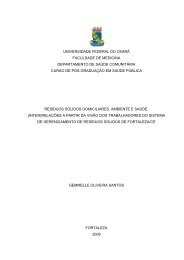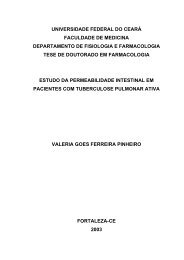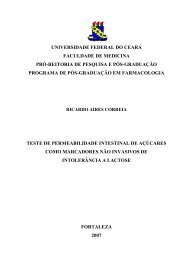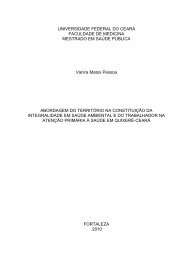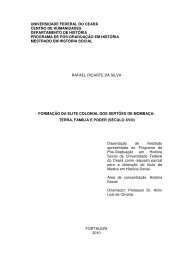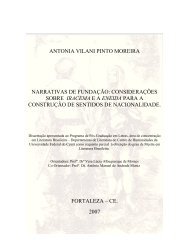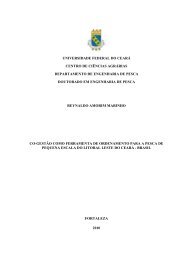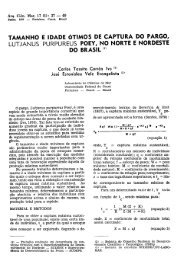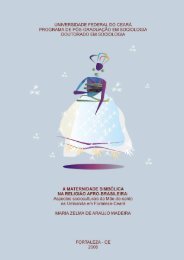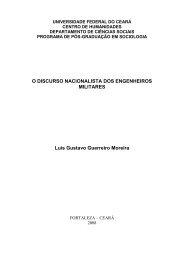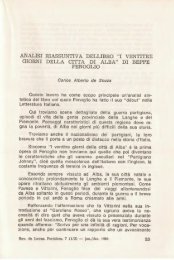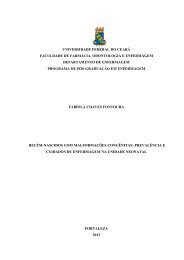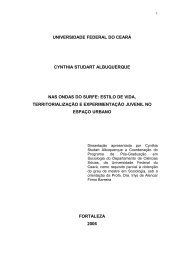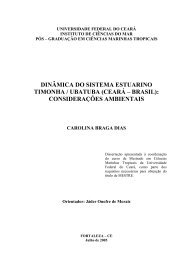Tungíase: doença negligenciada causando patologia grave
Tungíase: doença negligenciada causando patologia grave
Tungíase: doença negligenciada causando patologia grave
You also want an ePaper? Increase the reach of your titles
YUMPU automatically turns print PDFs into web optimized ePapers that Google loves.
Tropical Medicine and International Health volume 15 no 7 pp 856–864 july 2010<br />
L. Ariza et al. Rapid community assessment of tungiasis<br />
Figure 2 Right foot of a patient with approximately 100 sand flea<br />
lesions with several periungual lesions. Periungual site is exemplified<br />
by circles around the toe nail.<br />
association (R 2 ) and operational aspects, such as time<br />
needed to perform an examination, simplicity and disturbance<br />
to the individuals. R 2 indicates the per cent of<br />
variation of one variable that can be explained by linear<br />
relationship with another variable.<br />
Ethical aspects<br />
Studies were approved by the respective Ethical Review<br />
Boards (Ethical Review Board of the Federal University of<br />
Ceará, Ethical Committee of the School of Medical<br />
Sciences of Alagoas, Brazil; ad hoc Ethical Committee of<br />
Cascavel Municipality, and Ethical Committee of the<br />
University of Ilorin, Nigeria). Meetings with community<br />
health workers and village representatives were held prior<br />
to the studies, in which objectives were explained in detail.<br />
Informed written consent was obtained from individuals or<br />
their caretakers. In case of illiteracy, the informed consent<br />
form was read out by one of the investigators, and<br />
approval was obtained by thumb prints. In Nigeria, the<br />
traditional chiefs of Badagry (Ankra) and of local communities<br />
(Baales) also approved the study.<br />
Results<br />
General characteristics<br />
In total, 7121 individuals were included in the 10 surveys.<br />
This corresponded to 57.8–91.1% of the respective target<br />
populations (Table 2). Median age of the populations<br />
ranged between 13.5 and 20 years.<br />
Prevalence and severity of tungiasis varied considerably<br />
between and within communities (Table 2), with point<br />
Table 2 Characteristics of study populations and infestation status in 10 population-based surveys<br />
Brazil Nigeria<br />
1 2 3 4 5 6 7 8 9 10<br />
Survey No.<br />
Individuals 548 ⁄ 605 505 ⁄ 605 535 ⁄ 605 1185 ⁄ 1468 1192 ⁄ 1468 849 ⁄ 1468 1015 ⁄ 1146 990 ⁄ 1087 186 ⁄ 260 116 ⁄ 160<br />
examined ⁄ total (90.6%) (83.5%) (88.4%) (80.7%) (81.2%) (57.8%) (88.6%) (91.1%) (71.5%) (72.5%)<br />
population<br />
(% of target<br />
population)<br />
Prevalence of 51.3% 52.1% 31.2% 33.6% 23.7% 54.4% 21.1% 28.9% 51.1% 41.8%<br />
tungiasis (95% CI) (47.1–55.5) (47.7–56.5) (27.3–35.2) (30.9–36.3) (21.3–26.2) (51.1–57.8) (18.6–23.6) (26.1–31.7) (43.8–58.3) (28.4–55.3)<br />
Male ⁄ female 1.1 1.0 1.3 1.7 1.6 1.3 1.2 1.2 1.3 1.1<br />
prevalence ratio<br />
Number of lesions:<br />
Median (IQR ) 2 (1–6) 3 (1–8) 3 (1–8) 3 (1–9) 2 (1–5) 3 (1–8) 2 (1–3) 2 (1–4) 6 (2–15) 3 (2–11)<br />
Maximum 145 199 78 158 50 115 42 45 75 40<br />
Prevalence of 6.0% 6.5% 2.8% 2.2% 1.3% 4.7% 0.1% 0.8% 10.2% 5.2%<br />
severe tungiasisà (4.2–8.4) (4.5–9.1) (1.6–4.6) (1.4–3.2) (0.8–2.2) (3.4–6.4) (0.0–0.5) (0.3–1.6) (6.3–15.5) (1.9–10.9)<br />
(95% CI)<br />
ª 2010 Blackwell Publishing Ltd 859<br />
Interquartile range.<br />
à>20 lesions.



